A 20 image series of two Tundra Swans joined at the hip at takeoff. Photographing these gregarious birds at takeoff and doing it well was more difficult than I thought it would be.
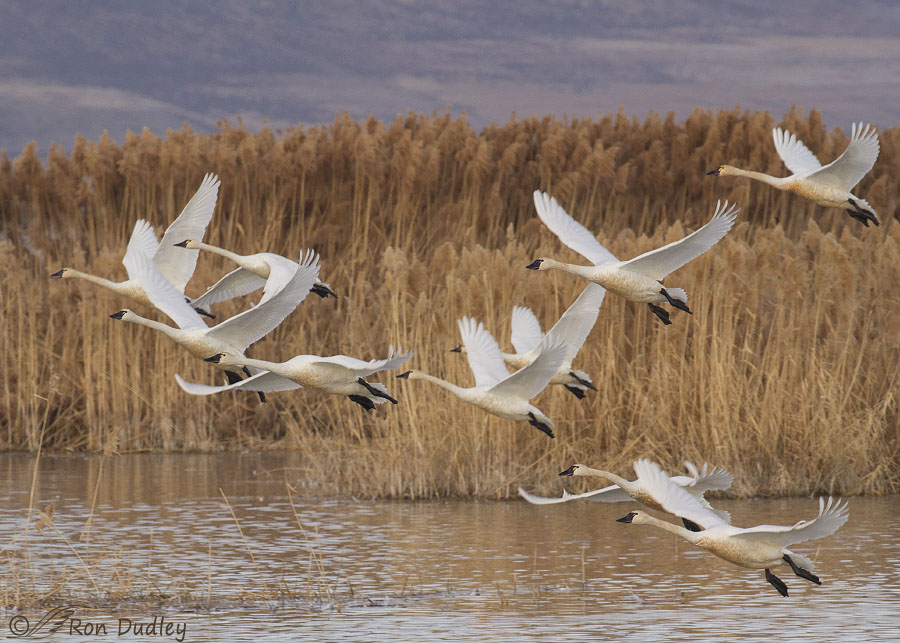
1/640, f/9, ISO 800, Canon 7D Mark II, Canon EF 100-400mm f/4.5-5.6L IS II USM @ 400 mm, not baited, set up or called in
Three days ago I spent about 45 minutes photographing a large group of Tundra Swans at Bear River MBR. There were about 125-150 birds in the group and they were calm and accepting of my presence (which surprised me). Every few minutes a cluster of them would take off and occasionally more flew in and joined the group on the water so I had many opportunities to photograph them landing, taking off and in flight. But it wasn’t easy to do well.
They tended to take off in tightly packed groups like this so getting a single bird isolated in the frame or a couple of them well separated from each other was a huge challenge. When they started to take off I had to choose a bird or two to focus on and hope my chosen subjects started to spread out in flight so that body parts of one bird didn’t obstruct other swans in the frame. Usually that didn’t happen so I got a lot of messy images that I’ll soon be deleting.
But with the following takeoff sequence I got lucky. I was able to get 59 photos of two swans taking off and in flight with very few clipped or cut off body parts, most of them were sharp and properly exposed and the birds were usually well separated from each other. I’m including 19 of those images below, presented in the order they were taken.
- If you’re interested in how many photos were skipped between the images I’ve included you can read the image file numbers by passing your cursor over the photos (that only works if you’re using a mouse with your device).
Ok, here goes…

1/1600, f/8, ISO 500, Canon 7D Mark II, Canon EF 500mm f/4L IS II USM + EF 1.4 III Extender, not baited, set up or called in
This was the first shot I was able to get of the two swans taking off, It usually takes a second or two to get them in my viewfinder after I hear or see them beginning to take off. For the next 14 shots there were so many other swans on the water in the background that I haven’t included them.
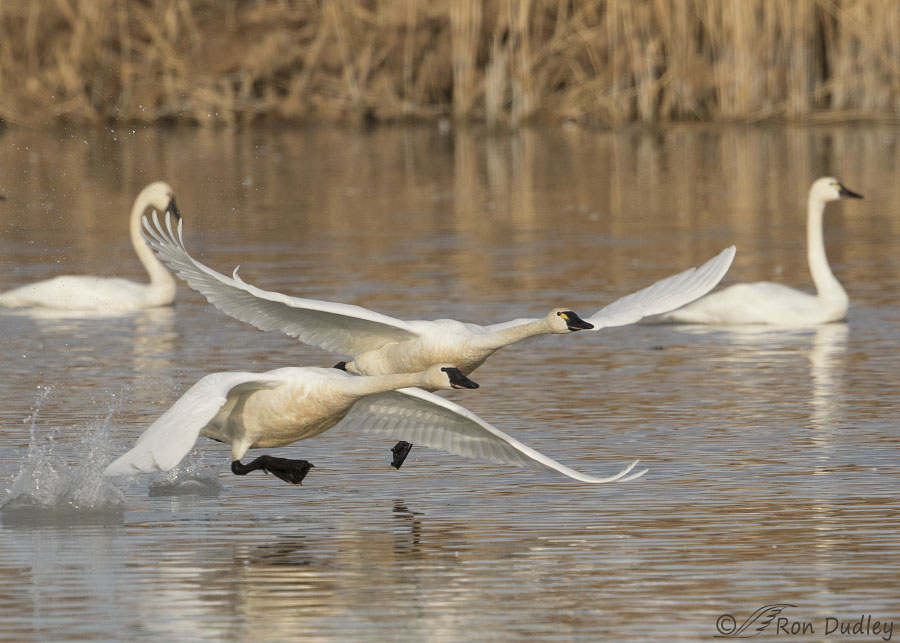
1/1600, f/8, ISO 500, Canon 7D Mark II, Canon EF 500mm f/4L IS II USM + EF 1.4 III Extender, not baited, set up or called in
Fourteen shots later the pair was mostly between two swans in the background and I didn’t find that quite so distracting.
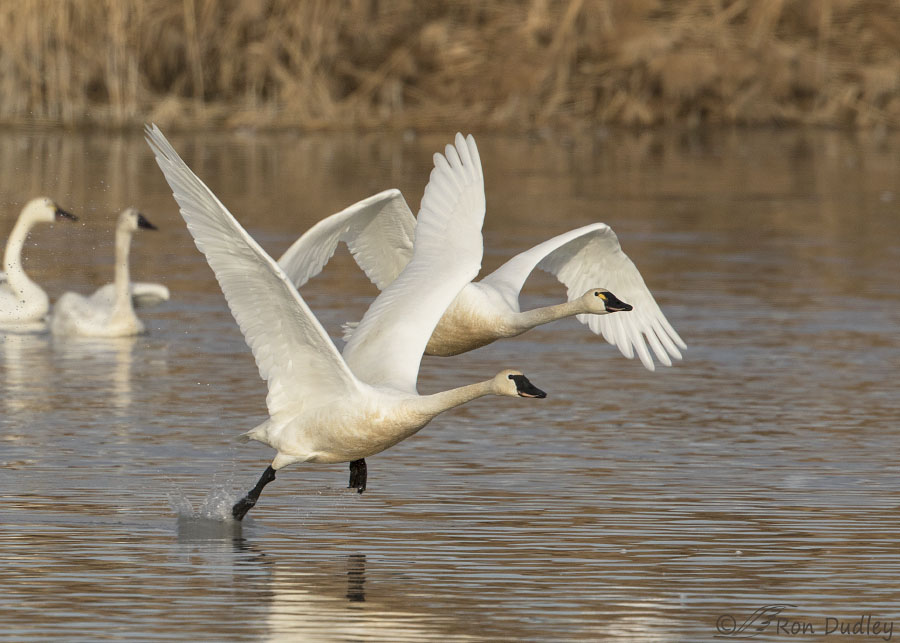
1/2000, f/8, ISO 500, Canon 7D Mark II, Canon EF 500mm f/4L IS II USM + EF 1.4 III Extender, not baited, set up or called in
Now they’re mostly clear of the background birds watching the show.
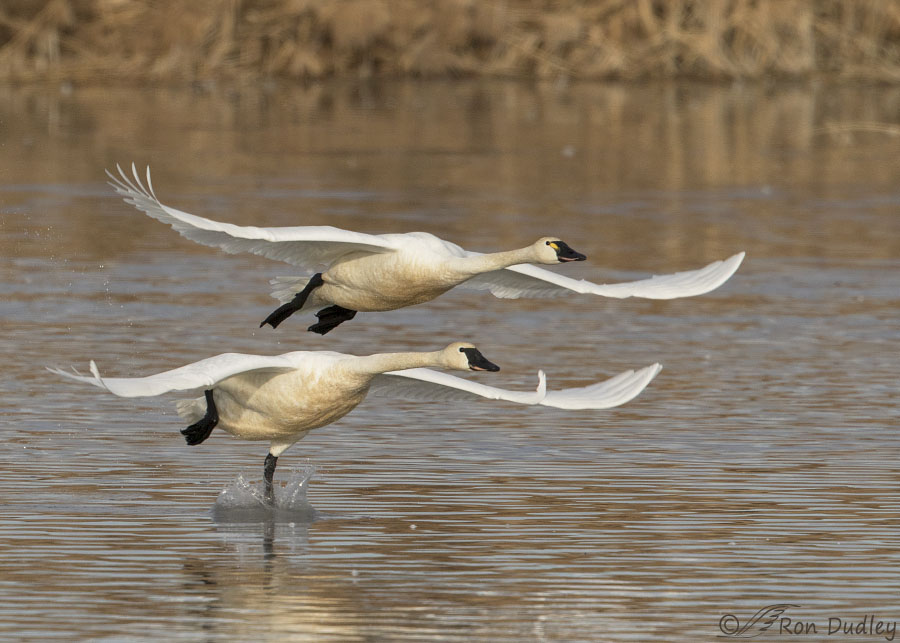
1/1600, f/8, ISO 500, Canon 7D Mark II, Canon EF 500mm f/4L IS II USM + EF 1.4 III Extender, not baited, set up or called in
I got several shots similar to this one. It was considerate of the swans to be well separated while being so close to each other. I had just enough depth of field to get both birds sharp enough.
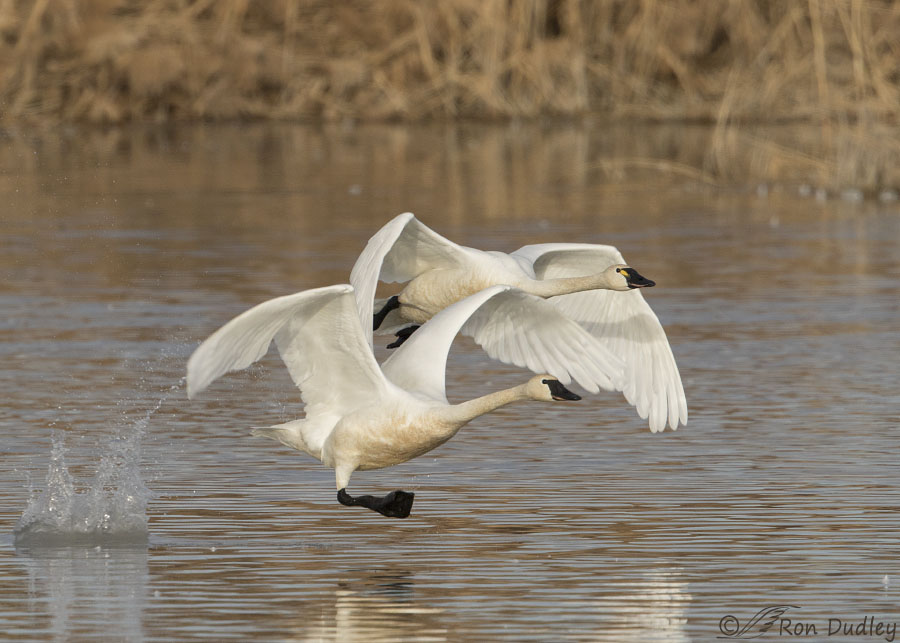
1/1600, f/8, ISO 500, Canon 7D Mark II, Canon EF 500mm f/4L IS II USM + EF 1.4 III Extender, not baited, set up or called in
Sometimes they didn’t have to be completely separated for me to enjoy the image. Here I’ve centered the birds in the frame in order to include the water splash at left.
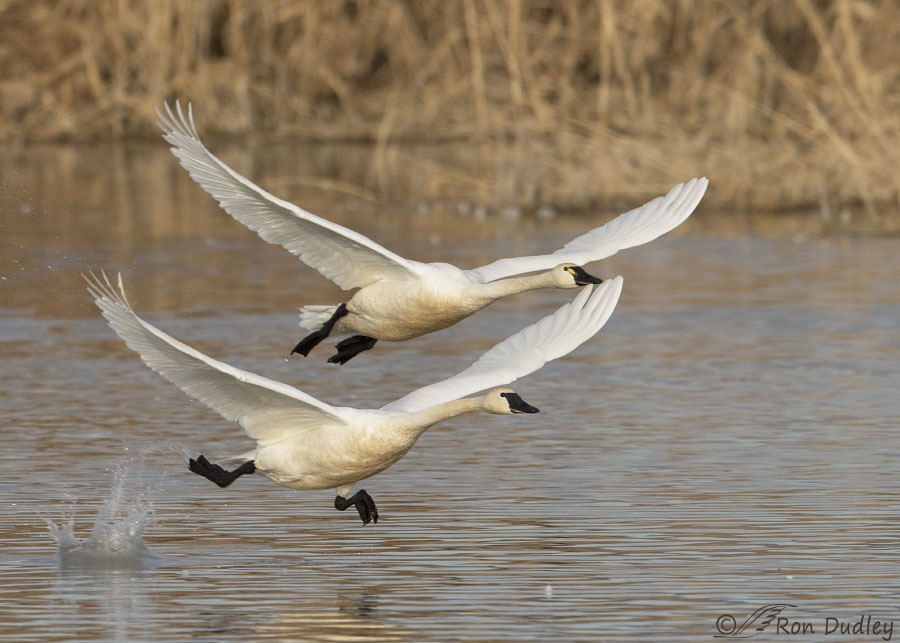
1/2000, f/8, ISO 500, Canon 7D Mark II, Canon EF 500mm f/4L IS II USM + EF 1.4 III Extender, not baited, set up or called in
I like the running pose of the swan at bottom but I do wish the tip of the bill of the top bird wasn’t obstructed by the other bird’s wing tip.
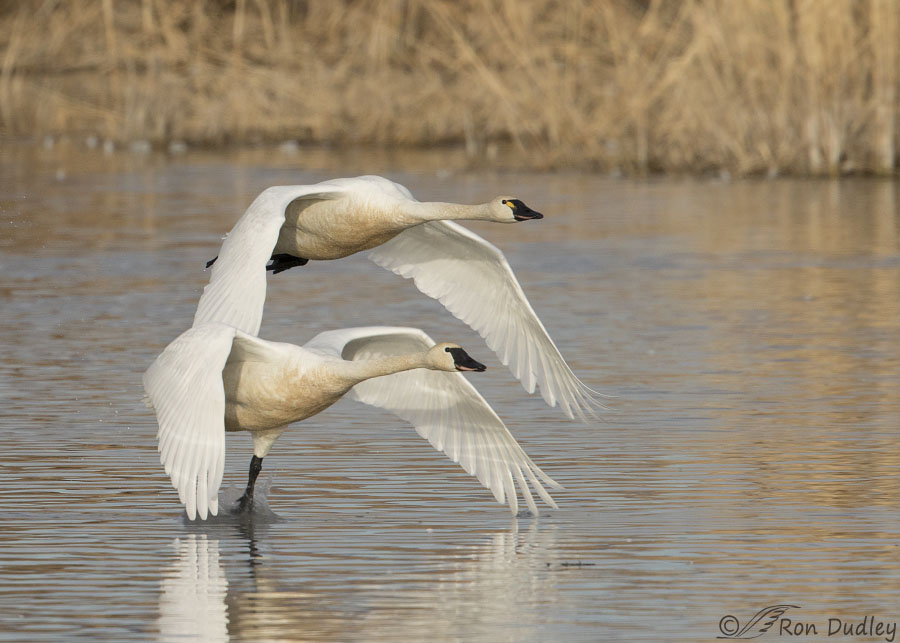
1/1600, f/8, ISO 500, Canon 7D Mark II, Canon EF 500mm f/4L IS II USM + EF 1.4 III Extender, not baited, set up or called in
Once again separation isn’t complete but I still enjoy the image.
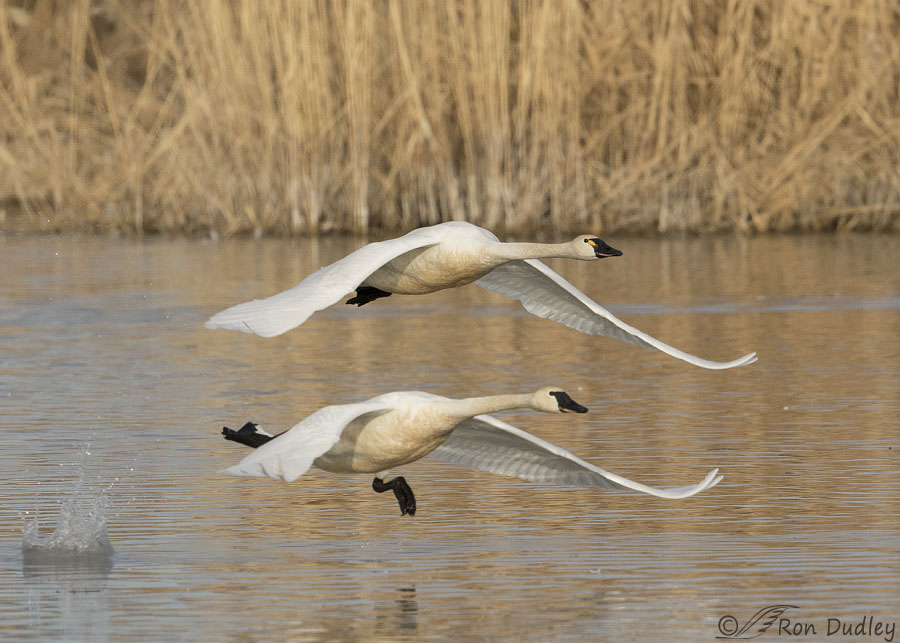
1/1600, f/8, ISO 500, Canon 7D Mark II, Canon EF 500mm f/4L IS II USM + EF 1.4 III Extender, not baited, set up or called in
The pose of the bottom bird might be my favorite running pose in the series because it’s so athletic. Once again I centered the birds to include the water splash.

1/1600, f/8, ISO 500, Canon 7D Mark II, Canon EF 500mm f/4L IS II USM + EF 1.4 III Extender, not baited, set up or called in
This was the last contact with the water I actually photographed.
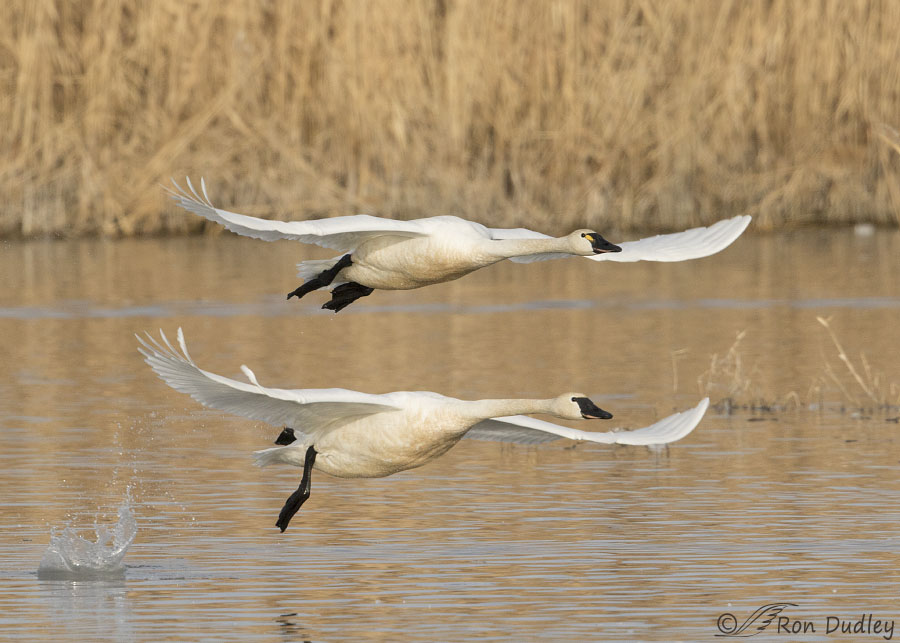
1/2000, f/8, ISO 500, Canon 7D Mark II, Canon EF 500mm f/4L IS II USM + EF 1.4 III Extender, not baited, set up or called in
I love the layered look of the swans here.
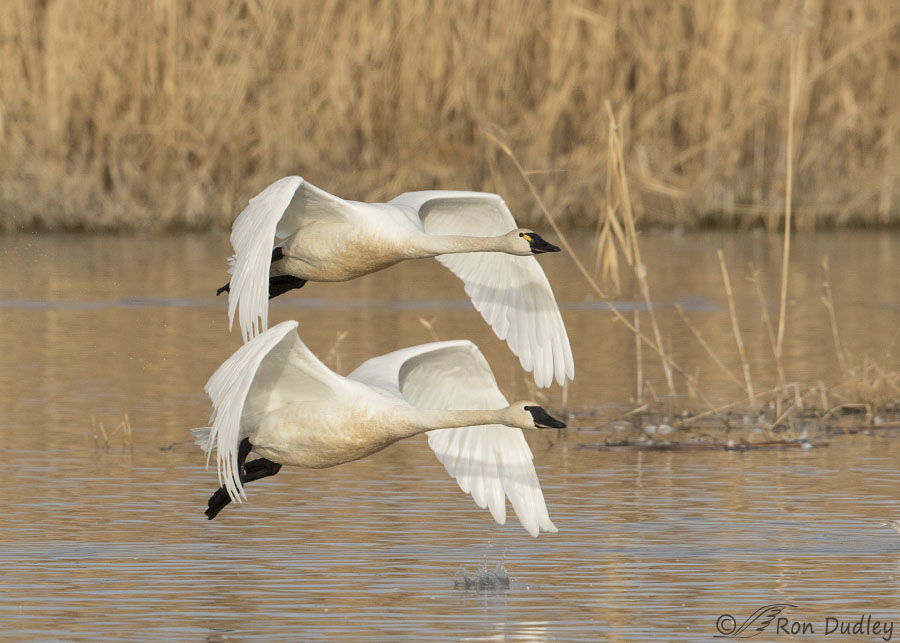
1/1600, f/8, ISO 500, Canon 7D Mark II, Canon EF 500mm f/4L IS II USM + EF 1.4 III Extender, not baited, set up or called in
After liftoff I didn’t get any shots of their wingtips touching the water but I got several where we can see the splash it produced. This is one of them…
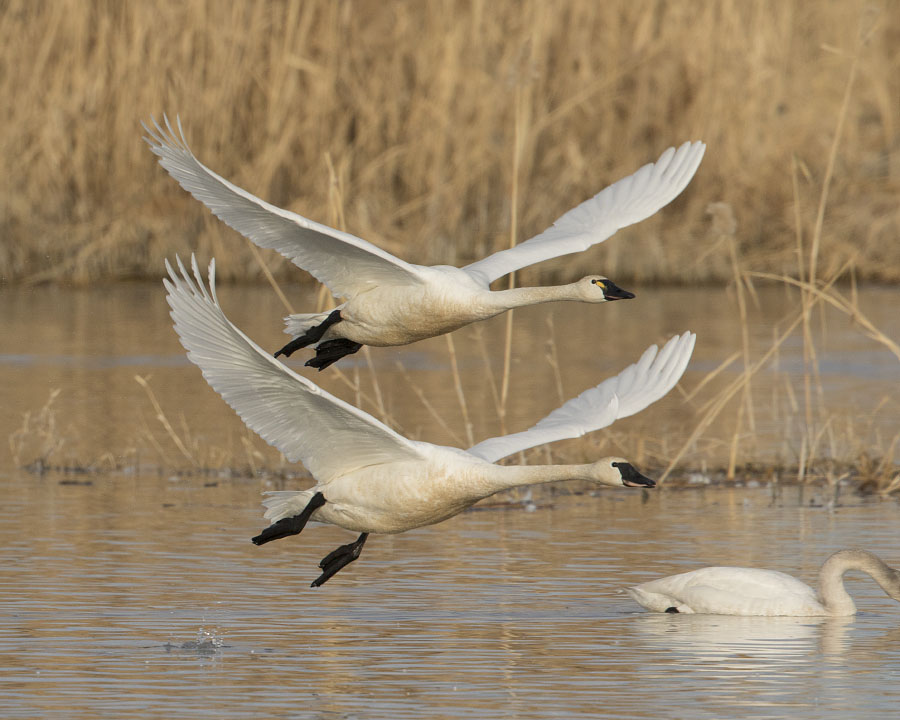
1/1600, f/8, ISO 500, Canon 7D Mark II, Canon EF 500mm f/4L IS II USM + EF 1.4 III Extender, not baited, set up or called in
and this is another. I’d like the image better if I hadn’t cut off the head of the swan on the water.
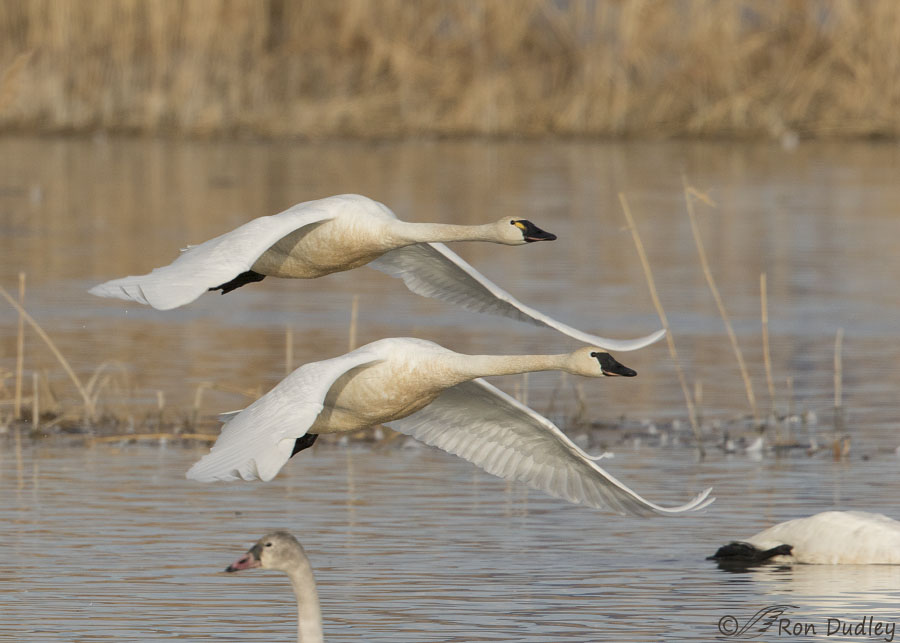
1/1600, f/8, ISO 500, Canon 7D Mark II, Canon EF 500mm f/4L IS II USM + EF 1.4 III Extender, not baited, set up or called in
In this shot and the next two the head of a swan sticks up into the frame at bottom (this one with a darker head and lighter bill is a juvenile). I do find it distracting to a point but I still like the images.
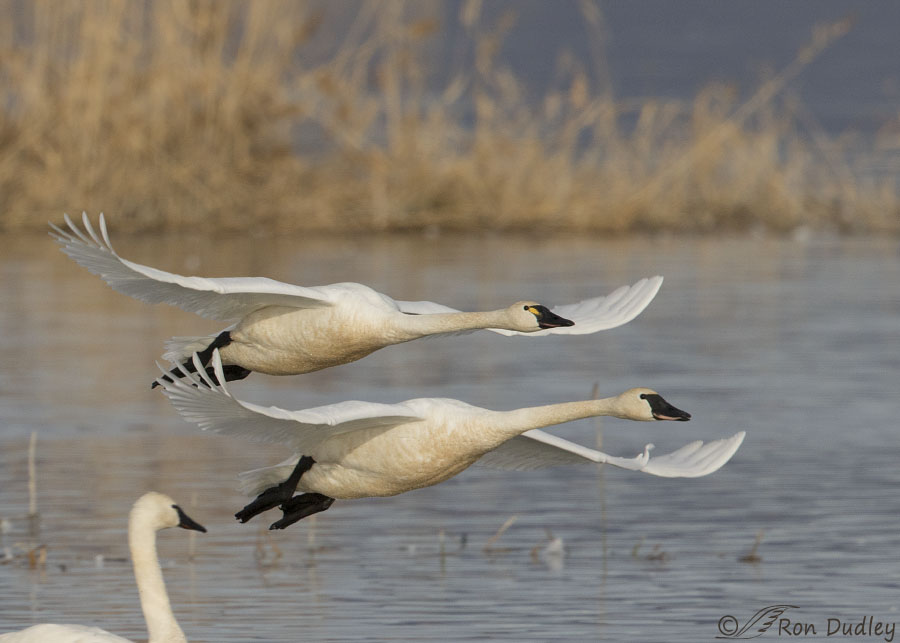
1/1600, f/8, ISO 500, Canon 7D Mark II, Canon EF 500mm f/4L IS II USM + EF 1.4 III Extender, not baited, set up or called in
It takes a while for these 14 lb. birds to gain both speed and elevation so even after taking 31 shots (so far) in the sequence they’re still close to the water.
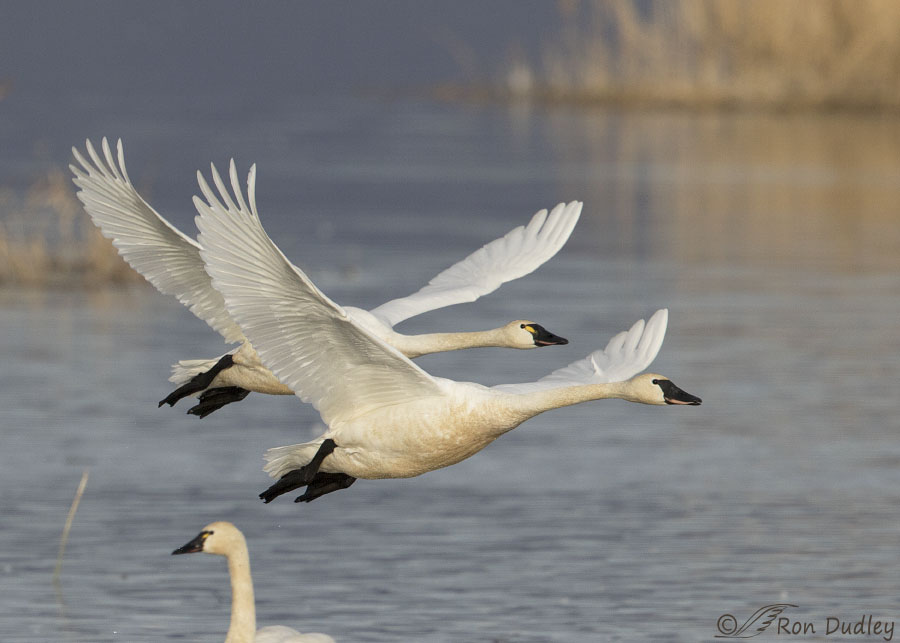
1/2000, f/8, ISO 500, Canon 7D Mark II, Canon EF 500mm f/4L IS II USM + EF 1.4 III Extender, not baited, set up or called in
This is the final shot in the series that included other swans in the frame.
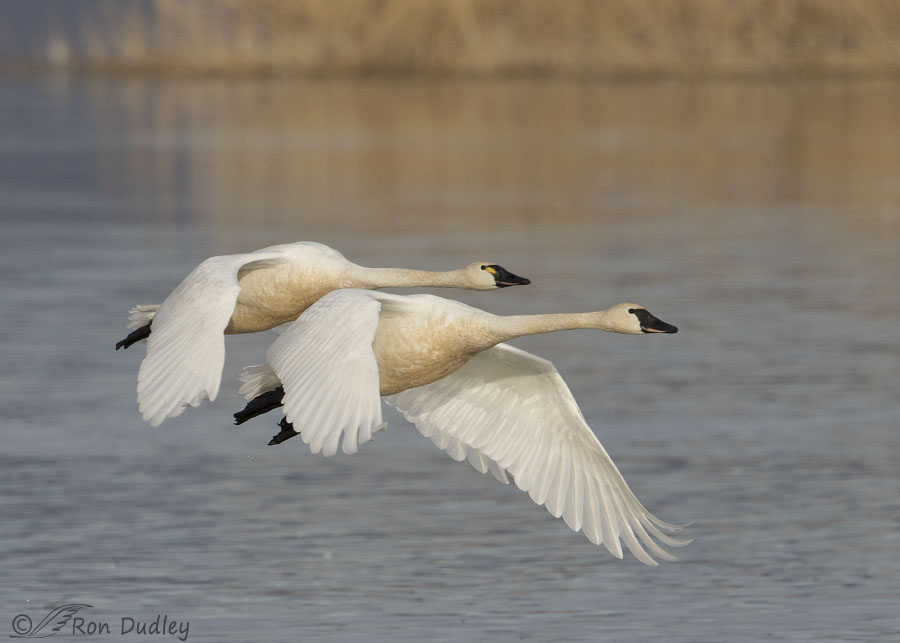
1/2000, f/8, ISO 500, Canon 7D Mark II, Canon EF 500mm f/4L IS II USM + EF 1.4 III Extender, not baited, set up or called in
Now they have sufficient air speed to gain elevation faster.
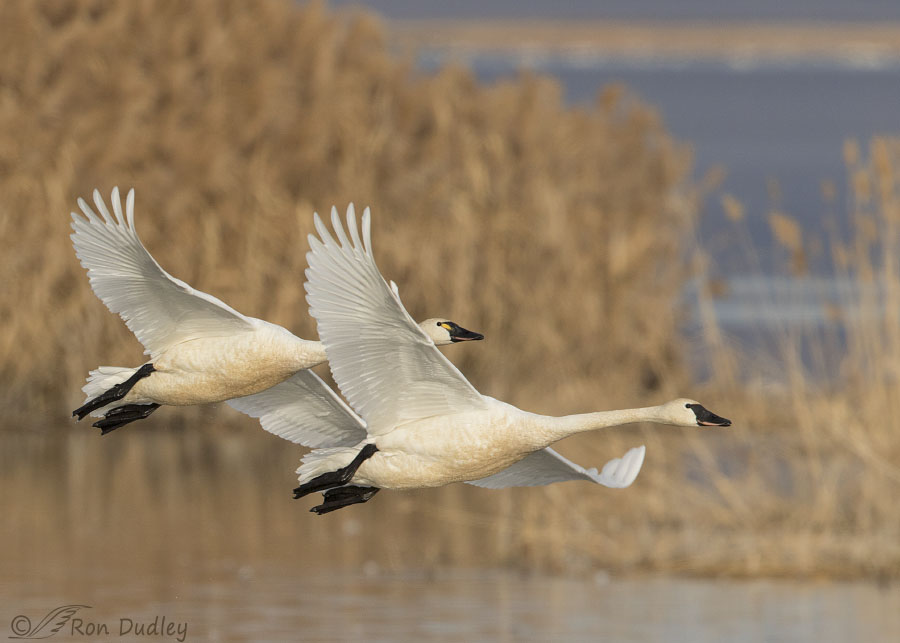
1/1600, f/8, ISO 500, Canon 7D Mark II, Canon EF 500mm f/4L IS II USM + EF 1.4 III Extender, not baited, set up or called in
I debated whether or not to include this photo because of the obstructed swan but in the end I decided I liked the peekaboo effect.
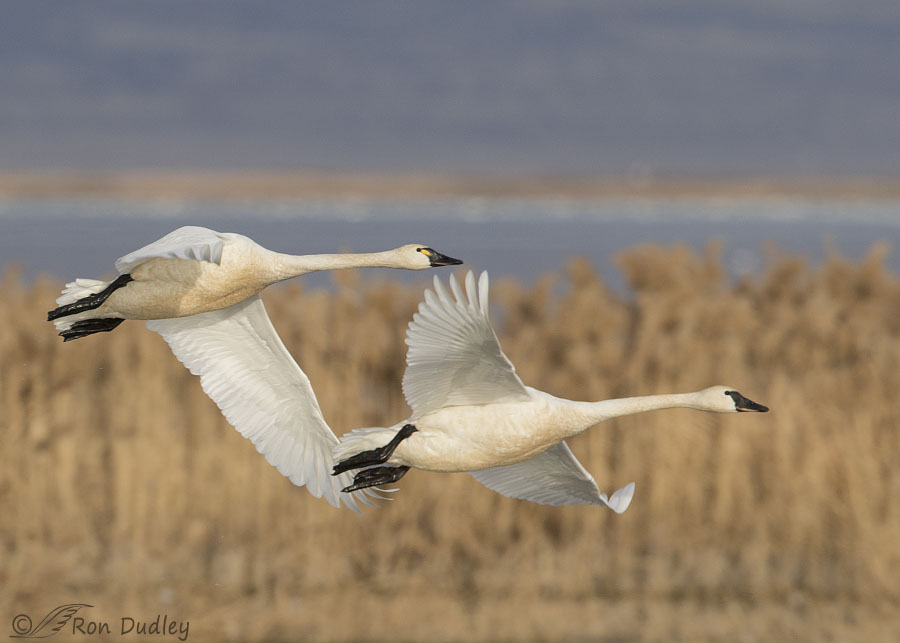
1/1250, f/8, ISO 500, Canon 7D Mark II, Canon EF 500mm f/4L IS II USM + EF 1.4 III Extender, not baited, set up or called in
Now they’re high enough to provide a better sense of the vast expanse of the refuge in the background. The blurry white blobs on the water are more swans.
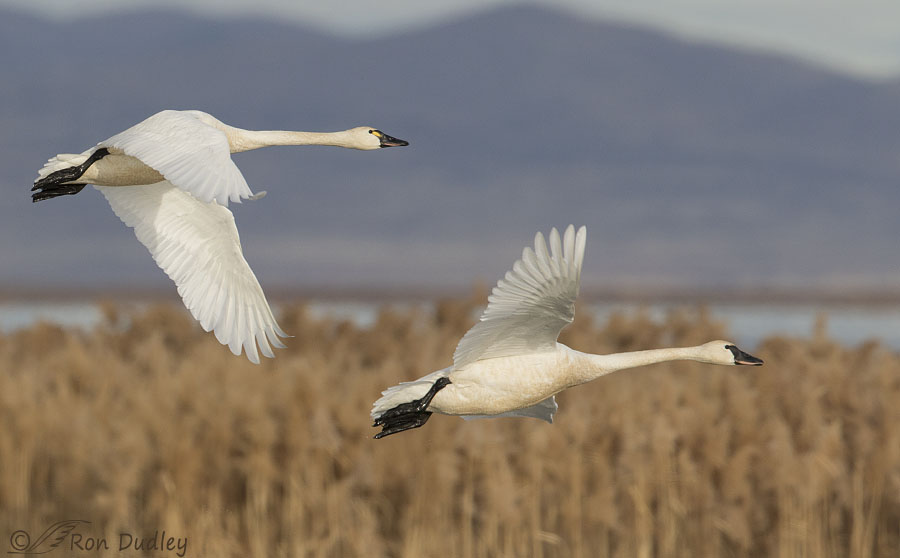
1/1600, f/8, ISO 500, Canon 7D Mark II, Canon EF 500mm f/4L IS II USM + EF 1.4 III Extender, not baited, set up or called in
This is the final shot I’m including because the swans were beginning to bank and turn away from me as they began to head north.
Twenty images in a single post is a new record for me. I hope it wasn’t too much for my readers to wade through but I couldn’t see breaking them up into several posts. It seems to me that seeing the (mostly) complete series at one sitting provides the reader with a better sense of the entire takeoff experience.
Ron


Oh, Ron, this is spectacular! What a series. It made me happy just to scroll through your lovely images. I’m curious … I know someone who just got a 7D and is struggling to learn the Canon AF and best settings for wildlife shots. Can I ask, on a Canon, what type of AF settings you use in a situation like this? I know nothing about the Canon system and am not of any help whatsoever.
Thank you, Ingrid. I’m assuming you meant that your friend just got a 7D Mark II like mine instead of the much older 7D. AF settings on the Mark II are quite complicated but here are the basic settings I was using for this series: Case I, AI Servo with only the center focus point active. Hope that helps.
Thanks very much, Ron. I’ll pass that along to her. Yes, she said the learning curve has been a bit challenging, and she ended up with a lot of soft photos. When she reset the camera parameters to default, it was better, so there was obviously something she changed through her tutorials that also altered the way her AF was working.
Not too many photos. Beautiful series. Wasn’t it fun! I enjoyed the same event Sunday but the light was not as good. I still got some nice shots. I had to crank up the ISO because I wanted more depth of field for the expanse of those big wings. I hope to have a repeat day but as you know no two days are alike at the refuge.
Good! I was hoping you were happy with some of your swan images, April. And yes, it was fun!
1021 and 1025 are my favorites – I love the symmetry and the way they fill the frame. (And I can see the alt tags without a mouse, by holding my finger over the image on a track pad.)
Thanks for the tip, Mo. If it doesn’t have a mouse it’s Greek to me….
WOW! At the risk of being ridiculously redundant again, just OH WOW! As you know, I love the behavioral series you present and no, 20 was NOT too many. That said, I had to linger on each one while enjoying my morning coffee along with the chaos of my juvenile Brittany going in and out and back again, chasing backyard birds, running (and sounding) like I’ve lit his butt on fire! What a combination!
But back to the plot. Like Marty I kept trying to pick a favorite and that just wasn’t available. With swans, I’m always amazed that those huge birds achieve flight in the first place.
I hate it that their feathers are stained with iron in the water, but that makes me wonder about their molt. Don’t they molt every year, producing a brand-new (white) set? That idea then leads me to the next question of how long it takes for the staining to happen. Now I’ve got to go look up those bits of information 😉
And the “synchronized swanning idea,” yeah I love that!! Marty, you ROCK!
Thank you, Laura. If I remember correctly they molt twice each year. I imagine that the time it takes to stain their plumage depends on the concentration of iron compounds in the water they swim on.
True, the concentration of iron would make a huge difference. Then that leads to the question of concentration of pollutants, doesn’t it? And if they molt twice a year, it must not take a long time for the staining to happen. Don’t you just love it that the answer to one question generally leads to another question or questions? I find that challenging and intriguing. I just love intellectual wanders, but sometimes they take big chunks of time, which isn’t all that bad 😉
Like Patty and Everett, I was struck with the”synchronized swanning”—-was that in part due to your selection process, or to mated pairs, or ? Sure makes for beautiful compositions !
I think it was largely a matter of luck, Kris, although the size of the birds and the length of their wings are almost identical so that makes the speed of their wing-strokes very similar.
“Wing size”—interesting….
Beautiful series! Thanks so much. I love the photo education as well as the exquisite look at these birds. You’ve got some real killer photographs in this collection.
“I love the photo education ”
Joanne, there’s nothing better than a nice image (or 20) to illustrate and reinforce factual information. Thank you.
Outstanding series, Ron!
Thanks, Dennis.
Good morning Ron! I am impressed at these beautiful action shots, thank you so very much. Once “Crazy Legs” got the legs & feet working it was like watching a series of synchronized flying. Thank you for the link to Mia’s Blog which I am enjoying so much.
“Crazy Legs”, I like that, Shirley.
A WONDERFUL SERIES!!! I notice that although their wings and tops of their bodies are very white, their heads, necks and lower bodies are darker….water stains???
Thanks, Patty. Yes. Their surfaces that are often in contact with water become stained by iron in the water.
These are tough to do.
🙂
New olympic event: Synchronized Swanning. 😉 This is such a fabulous series, Ron! I kept saying, “This is my favorite shot. No, this one. No, THIS one.” (rinse and repeat). I feel like I was there.
“I feel like I was there”
Good! That’s often my intention with posts like this and it was today. Thanks for that feedback, Marty.
Pretty funny! “Synchronized swanning”….
Nice series, Ron. I find it fascinating that almost all my photo series of geese, similar to these shots, show that the geese, more often than not, get their wings synchronized with one another, very quickly after the first chaotic eruption to flight. I used to think it was coincidence, but over the years, I’ve decided that they actually coordinate their wing beats, even within the first seconds of motion. Would you concur with that observation?
“Would you concur with that observation?”
Yes, I think that tendency exists though in my experience it isn’t always reliable.
Wonderful shots, and you even got one with its yellow lore spot. Wonder if they take off in mated pairs?
“Wonder if they take off in mated pairs”
Dick, that’s hard to tell but it’s my guess that there’s a tendency to do so. But they take off singly, in pairs, in small groups and large groups and identifying a mated pair among them usually isn’t easy in my experience.
I understand. Your shots suggest it to me when they tend to take off in pairs. Very interesting.
Where the one swan shows up in the foreground, I had to laugh. PHOTOBOMB. ;D
Yup, there’s a photobomb cluster in this series, Arwen!
Fantastic & impressive series Ron! Also the blues and tans fit these birds so well. Love the running on water! If only we could do likewise…
“If only we could do likewise”
Wouldn’t that be fun! Thanks, Kathy.
Beautiful!!! The first one is my favorite !!! Love the beautiful warm fall colors behind them … Tundras are rare around here . There’s only an occasional sighting ..
Thank you, Marina.
WOW! Grinning ear to ear, Ron! Wonderful series capturing the take off of the swans.:) Glad it’s you and not me having to decide what to keep! 🙂 Is the yellow going from the eye on to the beak of the trailing swan an indicator of sex?
Thanks very much, Judy. No, the yellow lores aren’t a sex indicator. Both sexes have them although the yellow is reduced or absent in some individuals.